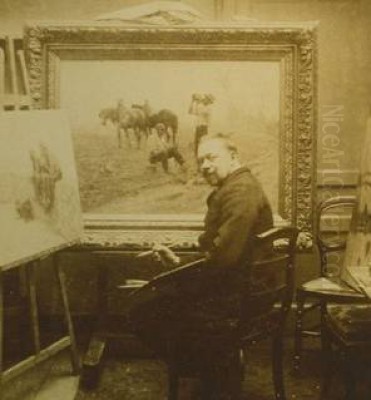
Georges Philibert Charles Maroniez stands as a significant figure in French painting during the late nineteenth and early twentieth centuries. Born in Douai, Nord, France, on January 17, 1865, and passing away in Paris on December 11, 1933, his life spanned a period of profound artistic change. Maroniez dedicated his artistic career primarily to capturing the landscapes, maritime scenes, and daily life of the French countryside and coastlines, particularly those of Northern France. He developed a distinctive style that, while rooted in realism, often conveyed a deep sense of atmosphere and tranquility.
Early Life and Artistic Beginnings
Born into a comfortable family in Douai – his father was an industrialist, owner of a sugar refinery – Maroniez initially pursued a path quite different from art. Following his family's wishes, he studied law and became a magistrate, holding positions in various towns including Boulogne-sur-Mer, Avesnes-sur-Helpe, and Cambrai. However, his passion for the arts, particularly painting, never waned.
His artistic inclinations likely developed early, nurtured by the cultural environment of Northern France. While fulfilling his legal duties, Maroniez actively pursued painting. He sought guidance from local artists, notably studying landscape painting in Douai under Pierre Binet. Later, while stationed near the coast, his connection with the sea deepened, and he received valuable advice from the established marine painter Eugène Boudin, a master renowned for his atmospheric depictions of Normandy's beaches and skies, often considered a precursor to Impressionism. This mentorship undoubtedly influenced Maroniez's approach to light and atmosphere in his own maritime works.
The Lure of the Sea: Maritime Themes
A significant portion of Maroniez's oeuvre is dedicated to the sea and the lives of those who depended on it. His time spent in coastal towns like Boulogne-sur-Mer provided him with firsthand exposure to the fishing communities and the dramatic landscapes of the Opal Coast. He became particularly associated with the depiction of scenes around Berck, the Bay of Somme, and especially Équihen-Plage, a village known for its rugged cliffs and fishing traditions.
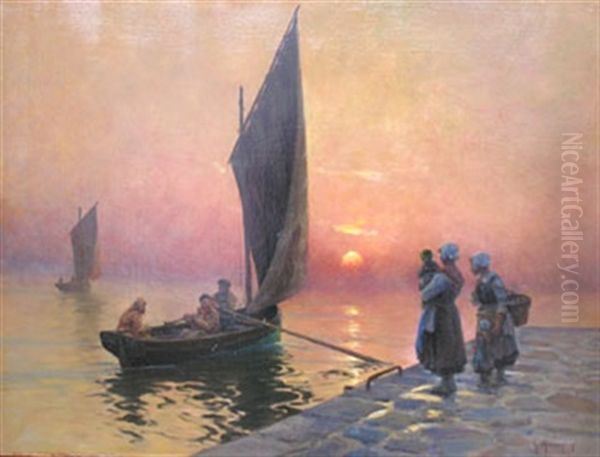
His maritime paintings often focus on the daily toil of fishermen. Works like Pêcheurs d'Equihen (Fishermen of Equihen), painted in 1902 and now housed in the Palais des Beaux-Arts in Lille, exemplify this theme. This painting portrays the strenuous effort and palpable fatigue of fishermen, likely hauling their boats or nets. It reflects a Naturalist interest in depicting the realities of working-class life, a trend prominent in French art following the Realism of Gustave Courbet and Jean-François Millet.
Another notable work, Retour de pêche (Return from Fishing), also dated 1902, captures the moment fishermen come back to shore, perhaps weary but successful. This oil painting, measuring 65 x 81 cm, appeared at a Drouot-Richelieu auction in 2021, indicating continued market interest in his work. Other titles like Setting Out to Sea in the Morning further underscore his focus on the cyclical rhythms of coastal life. These works often feature characteristic boats, vast skies, and the distinctive light of the northern coast.
The École de Wissant and Coastal Contemporaries
Maroniez is often linked with the École de Wissant (Wissant School), a loose group of artists active around the turn of the century who were drawn to the dramatic landscapes and unique light of the Cap Gris-Nez and Cap Blanc-Nez region on the Opal Coast, near the village of Wissant. This group shared an interest in capturing the atmospheric conditions and local life of this specific coastal area.
Key figures associated with the Wissant School included Adrien Demont and his wife, Virginie Demont-Breton. Virginie, daughter of the famous painter Jules Breton (known for his dignified portrayals of peasant life), was a successful artist in her own right, often depicting maternal and fishing scenes with sensitivity. Adrien Demont focused on the historical and dramatic aspects of the coastal landscape. Other members included Henri Duhem and his wife Marie Duhem, who painted landscapes and intimate scenes often imbued with a gentle luminism. Maroniez's work shares thematic and sometimes stylistic affinities with these artists, contributing to a regional artistic identity focused on the Opal Coast.
While the provided sources indicate no specific records of direct correspondence or close personal interactions between Maroniez and these or other contemporary painters like Claude Monet or Camille Pissarro, his participation in the artistic life of the region and his shared subject matter place him firmly within this milieu. His approach, however, often maintained a stronger narrative or descriptive element compared to the purely light-focused studies of the Impressionists.
The Tranquil Countryside: Rural Landscapes
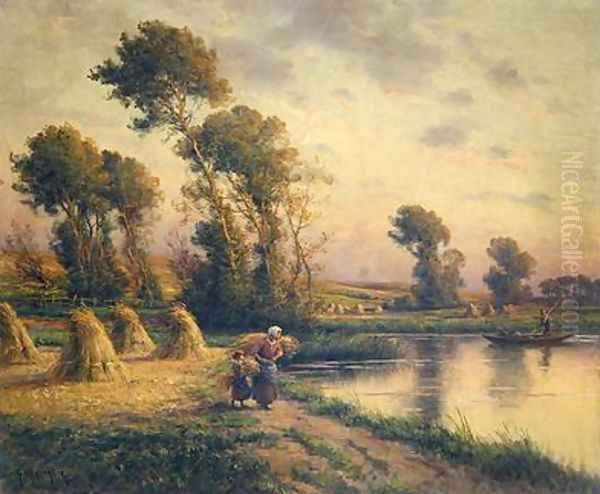
Beyond the coast, Maroniez also turned his attention inland, painting the fields, farms, and rural activities of Northern France. His landscape works often evoke a sense of peace, harmony, and connection to the land. A painting titled The Plowman directly addresses the theme of agricultural labor, a subject famously explored by earlier Realists like Millet, who sought to dignify the peasant worker.
Another work, simply referred to as Rural Landscape , is described as representing tranquility and harmony, presenting an idyllic vision of country life that contrasts with the perceived materialism of the age. The sources suggest these works might sometimes hint at quietude to the point of stillness, perhaps reflecting a desire for escape or a commentary on different modes of existence. These paintings showcase Maroniez's versatility and his ability to capture different moods and environments.
His rural scenes, like his coastal paintings, likely benefited from his keen observation skills. The depiction of light, the rendering of fields and trees, and the integration of figures into the landscape would have been key elements. While perhaps less dramatic than his maritime subjects, these works contribute significantly to his reputation as a painter of French regional life. They offer a counterpoint to the sometimes harsh realities depicted in fishing scenes, presenting a more serene aspect of the natural world and human interaction with it.
Artistic Style: Between Realism and Atmosphere
Georges Maroniez's style is not easily categorized under a single movement. His work clearly draws from the Realist and Naturalist traditions prevalent in the latter half of the 19th century, particularly in his choice of subject matter – the lives and labor of ordinary people, fishermen, and farmers. His detailed observation and desire to portray these scenes authentically align with the aims of artists like Courbet, Millet, and Jules Bastien-Lepage.
However, Maroniez's paintings often possess a strong atmospheric quality that goes beyond strict realism. His handling of light, especially in coastal scenes, suggests an awareness of Impressionist techniques, though he rarely dissolved form to the extent seen in Monet or Pissarro. Instead, he used light and color to evoke specific times of day, weather conditions, and the overall mood of the scene. Descriptions mention "delicate brushwork" and "soft colors," suggesting a sensitivity to nuance and a less rugged application of paint than some Realists employed.
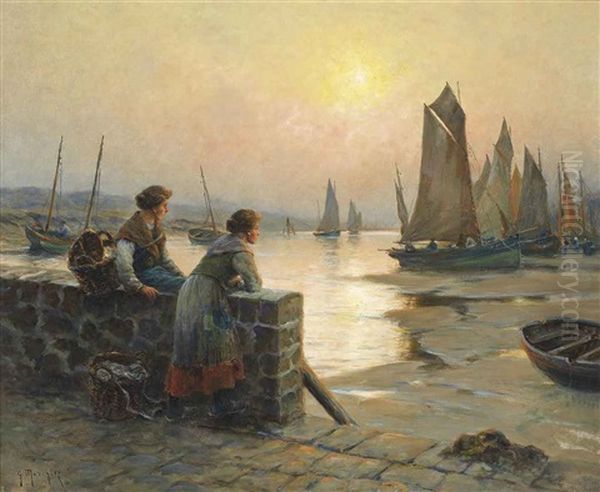
His work can be seen as occupying a space between academic tradition and modernist impulses. He maintained a focus on recognizable subjects and coherent compositions, yet infused them with a personal sensitivity to light and atmosphere, particularly the unique qualities of the Northern French coast. This blend of descriptive realism and atmospheric evocation defines his individual artistic signature.
Notable Works and Recognition
Several key works help define Maroniez's artistic contribution:
Pêcheurs d'Equihen (1902): A significant example of his focus on maritime labor, noted for its depiction of effort and fatigue. Housed in the Palais des Beaux-Arts, Lille.
Retour de pêche (1902): An oil painting capturing the return of fishermen, notable for its documented appearance in a 2021 auction.
The Plowman: Represents his engagement with themes of agricultural life and labor.
Rural Landscape: Highlights his ability to convey tranquility and harmony in nature.
Waiting : Likely a scene involving anticipation, perhaps related to fishing or rural life.
Setting Out to Sea in the Morning : Captures a specific moment in the daily routine of fishermen.
Port of Saint-Tropez : Indicates that Maroniez also travelled and painted scenes beyond Northern France, capturing the different light and atmosphere of the Mediterranean.
Scène de rivière (River Scene): An oil painting listed in a Drouot-Richelieu auction catalogue with an estimate of €600, showing his interest extended to riverine landscapes as well.
Maroniez achieved considerable recognition during his lifetime. He exhibited regularly and successfully at the prestigious Salon des Artistes Français in Paris, the main venue for artists seeking official acknowledgment. He received several awards at the Salon, including a third-class medal in 1891, a second-class medal in 1904, and ultimately the gold medal in 1906, signifying high esteem within the art establishment of the time. He was made a Knight of the Legion of Honour in 1912, a significant state recognition.
Beyond Painting: Photography and Invention
Interestingly, Maroniez's talents extended beyond the canvas. He was an early adopter and enthusiast of photography, particularly autochromes, an early color photography process invented by the Lumière brothers. He used photography not just as a potential aid for his painting but as an art form in its own right, capturing landscapes and scenes with this new technology. His photographic work provides another layer to his visual exploration of the world around him.
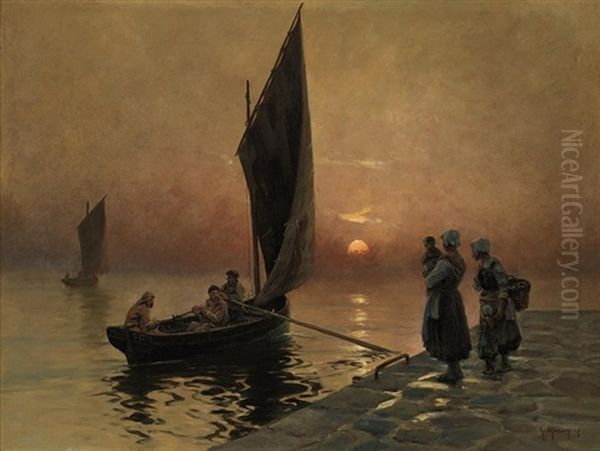
Furthermore, Maroniez possessed an inventive mind. He developed and patented a hand-held combined camera and projector, known as the "Maroniez Photo-Ciné," demonstrating a forward-looking interest in the burgeoning field of cinematography alongside his more traditional artistic pursuits. This multifaceted nature reveals a man deeply engaged with the visual technologies and artistic possibilities of his era.
Market Presence and Collections
Information regarding the comprehensive market history and institutional holdings of Maroniez's work is somewhat fragmented, according to the provided sources. However, certain points are clear. His paintings do appear on the art market, as evidenced by the mention of Retour de pêche (1902) at auction in 2021 and the listing of Scène de rivière at Drouot-Richelieu. The €600 estimate for the latter suggests that while recognized, his works might be relatively accessible compared to major Impressionist or Post-Impressionist names like Van Gogh or Gauguin, whose depictions of rural life often command much higher prices.
In terms of public collections, the Palais des Beaux-Arts in Lille is confirmed as holding Pêcheurs d'Equihen. It is highly probable that other museums, particularly regional institutions in Northern France (like Douai, Calais, Boulogne-sur-Mer, or Le Touquet), also hold examples of his work, given his strong connection to the area. His paintings are also likely present in numerous private collections in France and internationally.
Legacy and Conclusion
Georges Philibert Charles Maroniez carved out a distinct niche in French art at the turn of the twentieth century. He remained largely faithful to representational painting, focusing on the enduring themes of human interaction with nature, whether the demanding sea or the tranquil countryside. His work provides a valuable visual record of the coastal and rural life of Northern France during a period of gradual change.
His association with the École de Wissant highlights the importance of regional art movements in France, offering perspectives distinct from the dominant Parisian scene. While perhaps not as revolutionary as the Impressionists or Post-Impressionists, Maroniez developed a sensitive and atmospheric style that captured the specific character of his chosen locales. His ability to convey both the hardship of labor and the beauty of the natural world gives his work depth and enduring appeal.
As a painter, photographer, and inventor, Maroniez emerges as a figure engaged with both the traditions and innovations of his time. His legacy rests on his evocative depictions of the sea, the land, and the people of Northern France, rendered with a blend of realistic observation and atmospheric sensitivity that continues to resonate with viewers today. His paintings serve as quiet testaments to a way of life and a landscape he knew intimately and portrayed with dedication and skill.